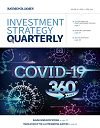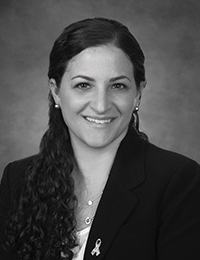COVID-19 Insights > What Should We Expect From the Markets Going Forward?
What Should We Expect From the Markets Going Forward?
Markets and Investing
Investors can anticipate lower returns for both bonds and stocks over the next several years vs. the last 10 years due to lower yield levels, starting valuations and economic conditions. Read more from Nick Lacy, CFA, Chief Portfolio Strategist for Asset Management Services.
U.S. equities have handsomely rewarded stock investors over the past 10 years, generating a 13.6% annualized total return as measured by the S&P 500 Index. This stands in stark contrast to returns on high-quality bonds over the same time period, which only returned approximately 3.6% per year as measured by the Bloomberg Barclays U.S. Aggregate Bond Index. However, the next 10 years will likely be very different than the last.
In order to make informed decisions when allocating assets, investors need to have a general idea of how each asset is expected to perform over a given time period. There are three broad asset classes that benefit from forecasting: stocks, bonds, and cash. Stocks tend to be the most difficult to forecast while bonds tend to be the least difficult.
Bonds
The best predictor of a return on a bond is the current yield on that bond, especially if it is a high-quality bond with a maturity matching the investor’s time horizon. For example, if an investor bought an investment-grade bond with yield to worst of 3%, the return over that time period would roughly equal 3% per year, all else being equal.
The yield of the Bloomberg Barclays U.S. Aggregate Bond Index has been a decent predictor of its future total returns. The current yield on U.S. investment-grade bonds is around 2.0%, which can be used to gauge return expectations over the next 5-10 years. It bears mentioning that this is substantially lower than the total returns of investment-grade bonds over the last 10-20 years. Current interest rates, not only in the U.S. but around the world, are much lower than they were before the financial crisis. With negative interest rates elsewhere around the world, this does not look like it will change any time soon.
Equities
Over time, equities should produce returns in line with earnings growth and dividends; however, the markets rarely do what they are supposed to do. The dividend yield on the U.S. equity market has hovered around 2% over the last 10 years, while earnings growth has been approximately 6.5% per year since 2010. Markets should have returned 8.5% (6.5% plus the 2% dividend yield). However, the market actually returned 13.6%, over 5.1% more per year. The fact that price-to-earnings (P/E) multiples expanded substantially from 2009 to 2019 helps explain the significant difference in returns over this time period.
What should investors expect going forward? Dividends are fairly constant and tend to average around 2%, while earnings or sales growth may vary. Research shows sales growth may be linked to economic growth and inflation, while earnings growth can be boosted by improving margins. What should we expect for economic growth over the next five years? Looking beyond 2020 and the impacts of COVID-19, consensus estimates indicate that U.S. GDP and inflation will grow at 2% each per year, which results in a 4% sales growth estimate. How much companies earn will depend on several factors, such as borrowing and profitability. If earnings growth is exactly the same as sales growth with a 2% dividend yield, investors should expect to see returns of 6% going forward (inflation plus GDP growth plus dividends). While returns could be boosted by an expansion in P/E multiples or additional borrowing beyond the levels seen thus far, this seems unlikely.
The moral of this story is that investors should expect to see both bonds and stocks return relatively less over the next several years compared to the past 10 years due to lower yield levels, starting valuations, and economic conditions.
Key takeaways
In order to make informed decisions when allocating assets, investors need to have a general idea of how each asset is expected to perform over a given time period. The three broad asset classes that benefit from forecasting are stocks, bonds and cash.
Current interest rates, not only in the U.S. but around the world, are much lower than they were before the financial crisis. With negative interest rates elsewhere around the world, this does not look like it will change any time soon.
Investors should expect to see both bonds and stocks return relatively less over the next several years compared to the past 10 years due to lower yield levels, starting valuations, and economic conditions.
Read the full April 2020 Investment Strategy Quarterly
Please note, changes in tax laws may occur at any time and could have a substantial impact upon each person’s situation. While we are familiar with the tax provisions of the issues presented herein, Raymond James Financial Advisors are not qualified to render advice on tax or legal matters. You should discuss tax or legal matters with the appropriate professional.
Links are being provided for information purposes only. Raymond James is not affiliated with and does not endorse, authorize or sponsor any of the listed websites or their respective sponsors. Raymond James is not responsible for the content of any website or the collection or use of information regarding any website’s users and/or members. Raymond James does not provide tax or legal services. Please discuss these matters with the appropriate professional.

 Maggie Slivinski
Maggie Slivinski Steve Corbo
Steve Corbo Alexandra Rao
Alexandra Rao Alexa Comey
Alexa Comey Gene Donato
Gene Donato Jack W. Kennedy III, CFP®, AAMS®
Jack W. Kennedy III, CFP®, AAMS® Henry (Hank) J. Schroeder, CFP®
Henry (Hank) J. Schroeder, CFP® Diane Gallagher
Diane Gallagher Scott Bernstiel
Scott Bernstiel Chrissy Carpenter
Chrissy Carpenter David Strout
David Strout Keith R. Hering AAMS®, CRPS®, CIMA®
Keith R. Hering AAMS®, CRPS®, CIMA®  Marjorie Onuwa
Marjorie Onuwa